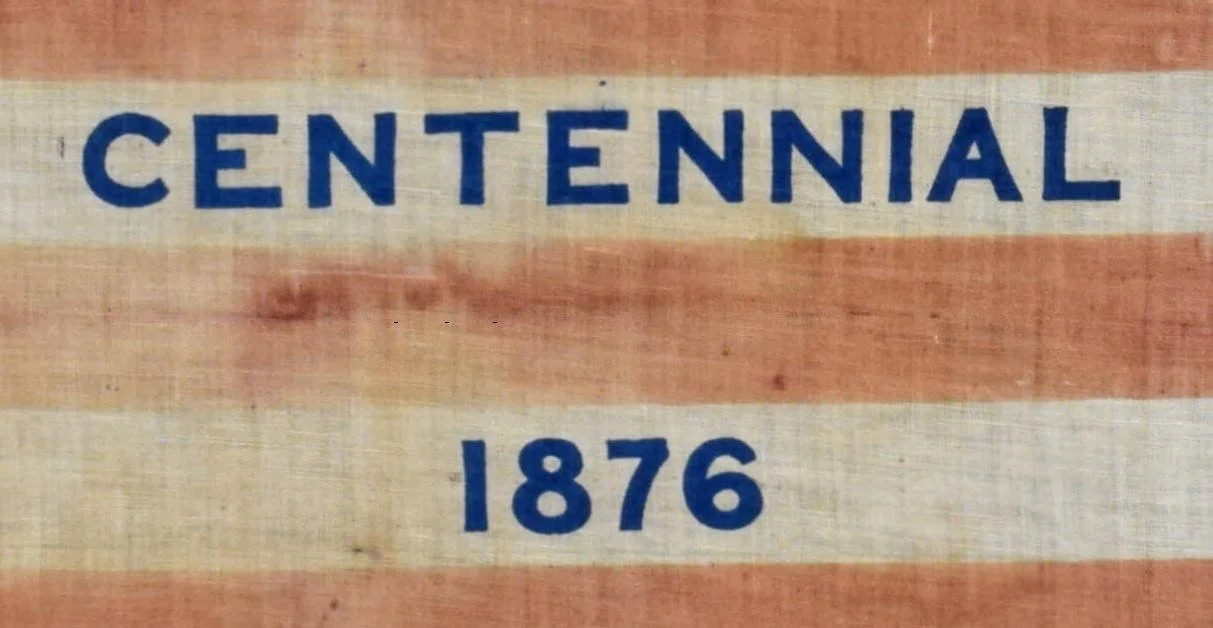38 Star Antique Flag | Includes a CENTENNIAL 1876 Overprint | Colorado Statehood | Circa 1876
38 Star Antique Flag | Includes a CENTENNIAL 1876 Overprint | Colorado Statehood | Circa 1876
Frame Size (H x L): 26.25” x 35.5”
Flag Size (H x L): 16” x 22.5”
Offered is a thirty-eight star antique flag. It features the following overprint: CENTENNIAL | 1876. The nation’s centennial inspired patriotism across the county and reunited its citizens, following the Civil War. Cities of all sizes hosted parades and celebrations, and buildings and homes were canvased in red, white, and blue with flags being the primary symbol of national pride. The most notable celebration was the Centennial International Exposition in Philadelphia. It is likely that this flag was made specifically for Philadelphia’s celebration, as these flags are most often discovered in (or near) Philadelphia. There are approximately twenty of these flags in circulation.
The stars of this flag are arranged in columns. There are seven stars in the first and last columns, and six stars in the other columns. The stars in the first, third, fourth, and sixth columns are facing downwards, while the stars in the other columns are facing upwards. The canton and the centennial overprint are the same blue, indicating that they were printed simultaneously. In contrast, most 19th century parade flags were printed, and then specific overprints would be added later in a different color (e.g., black).
This flag was manufactured in a reverse mount orientation. A reverse mount is one in which the canton of a US flag is positioned in the upper-right corner. Current flag ethics state that the canton should always be placed on upper-left, but such a requirement did not exist in the 19th century.
An example of this flag is documented in the Threads of History. It is featured as item 437 and was held in the private collection of Mr. and Mrs. Boleslaw Mastai. The Threads of History was written by Herbert Ridgeway Collins, who was the curator of the Division of Political History at the Smithsonian Institute. His book documents important political textiles, and includes over fifteen-hundred examples, dating from 1775 to 1979. In addition to being featured in the Threads of History, an example of this flag is also featured in the Stars and Stripes by J. Richard Pierce. The Pierce example includes writing along its hoist of the following: Philadelphia, Sept 1876, G.N.M. This supports the theory mentioned above that this style of flag was likely made for the Centennial International Exposition in Philadelphia.
The thirty-eight star flag represents the addition of Colorado to the Union. Colorado was admitted on August 1st, 1876 and this flag became official on July 4th, 1877. Presidents Hayes, Garfield, Arthur, Cleveland, and Harrison all served under this flag. Colorado became known as the “Centennial State,” a result of becoming official just twenty-eight days after the centennial. The official star count for US flags in 1876 was the thirty-seven star flag. However, it was common for flag makers to produce anticipatory flags in advance of their official date, making the thirty-eight star flag—and for historical reasons, the thirteen star flag—the most common flags flown during the centennial celebrations.
The thirty-eight star flag was official until July 4th, 1890, the time at which the forty-three star flag became official and began to represent the inclusion of North Dakota, South Dakota, Montana, Washington, and Idaho to the Union.
Conservation Process: This flag was hand sewn to cotton fabric, and both were hand sewn to a mounting board. To prevent the black dye in the cotton fabric from seeping into the flag, it was first washed in a standard wash and then in a dye setting wash. The flag is positioned behind Optium Museum Acrylic.
Frame: This offering is in our Large Distressed Black and Gold Frame.
Condition Report: There is moderate oxidation across the entire flag. There is some staining, particularly (1) below the canton, and (2) above, below, and through the “CENTENNIAL 1876” overprint. The red stripes are slightly faded.
Collectability Level: The Best – Perfect for Advanced Collectors
Date of Origin: 1876
Number of Stars: 38
Associated War: The Indian Wars (1860-1890)
Associated State: Colorado










